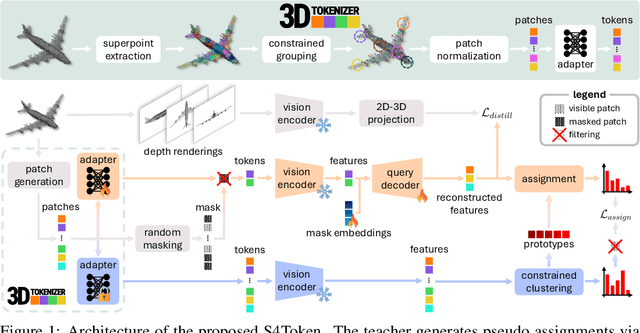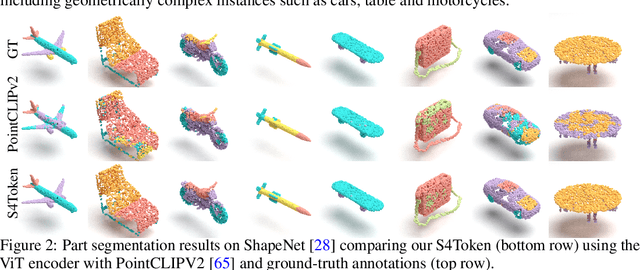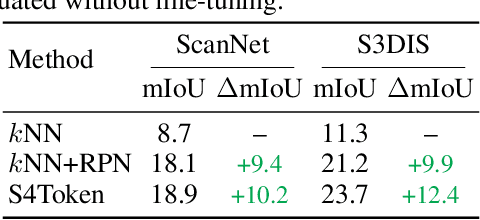Xu Zheng
refer to the report for detailed contributions
PhysToolBench: Benchmarking Physical Tool Understanding for MLLMs
Oct 10, 2025Abstract:The ability to use, understand, and create tools is a hallmark of human intelligence, enabling sophisticated interaction with the physical world. For any general-purpose intelligent agent to achieve true versatility, it must also master these fundamental skills. While modern Multimodal Large Language Models (MLLMs) leverage their extensive common knowledge for high-level planning in embodied AI and in downstream Vision-Language-Action (VLA) models, the extent of their true understanding of physical tools remains unquantified. To bridge this gap, we present PhysToolBench, the first benchmark dedicated to evaluating the comprehension of physical tools by MLLMs. Our benchmark is structured as a Visual Question Answering (VQA) dataset comprising over 1,000 image-text pairs. It assesses capabilities across three distinct difficulty levels: (1) Tool Recognition: Requiring the recognition of a tool's primary function. (2) Tool Understanding: Testing the ability to grasp the underlying principles of a tool's operation. (3) Tool Creation: Challenging the model to fashion a new tool from surrounding objects when conventional options are unavailable. Our comprehensive evaluation of 32 MLLMs-spanning proprietary, open-source, specialized embodied, and backbones in VLAs-reveals a significant deficiency in tool understanding. Furthermore, we provide an in-depth analysis and propose preliminary solutions. Code and dataset are publicly available.
Are We Using the Right Benchmark: An Evaluation Framework for Visual Token Compression Methods
Oct 08, 2025Abstract:Recent endeavors to accelerate inference in Multimodal Large Language Models (MLLMs) have primarily focused on visual token compression. The effectiveness of these methods is typically assessed by measuring the accuracy drop on established benchmarks, comparing model performance before and after compression. However, these benchmarks are originally designed to assess the perception and reasoning capabilities of MLLMs, rather than to evaluate compression techniques. As a result, directly applying them to visual token compression introduces a task mismatch. Strikingly, our investigation reveals that simple image downsampling consistently outperforms many advanced compression methods across multiple widely used benchmarks. Through extensive experiments, we make the following observations: (i) Current benchmarks are noisy for the visual token compression task. (ii) Down-sampling is able to serve as a data filter to evaluate the difficulty of samples in the visual token compression task. Motivated by these findings, we introduce VTC-Bench, an evaluation framework that incorporates a data filtering mechanism to denoise existing benchmarks, thereby enabling fairer and more accurate assessment of visual token compression methods. All data and code are available at https://github.com/Chenfei-Liao/VTC-Bench.
CIARD: Cyclic Iterative Adversarial Robustness Distillation
Sep 16, 2025Abstract:Adversarial robustness distillation (ARD) aims to transfer both performance and robustness from teacher model to lightweight student model, enabling resilient performance on resource-constrained scenarios. Though existing ARD approaches enhance student model's robustness, the inevitable by-product leads to the degraded performance on clean examples. We summarize the causes of this problem inherent in existing methods with dual-teacher framework as: 1. The divergent optimization objectives of dual-teacher models, i.e., the clean and robust teachers, impede effective knowledge transfer to the student model, and 2. The iteratively generated adversarial examples during training lead to performance deterioration of the robust teacher model. To address these challenges, we propose a novel Cyclic Iterative ARD (CIARD) method with two key innovations: a. A multi-teacher framework with contrastive push-loss alignment to resolve conflicts in dual-teacher optimization objectives, and b. Continuous adversarial retraining to maintain dynamic teacher robustness against performance degradation from the varying adversarial examples. Extensive experiments on CIFAR-10, CIFAR-100, and Tiny-ImageNet demonstrate that CIARD achieves remarkable performance with an average 3.53 improvement in adversarial defense rates across various attack scenarios and a 5.87 increase in clean sample accuracy, establishing a new benchmark for balancing model robustness and generalization. Our code is available at https://github.com/eminentgu/CIARD
PANORAMA: The Rise of Omnidirectional Vision in the Embodied AI Era
Sep 16, 2025Abstract:Omnidirectional vision, using 360-degree vision to understand the environment, has become increasingly critical across domains like robotics, industrial inspection, and environmental monitoring. Compared to traditional pinhole vision, omnidirectional vision provides holistic environmental awareness, significantly enhancing the completeness of scene perception and the reliability of decision-making. However, foundational research in this area has historically lagged behind traditional pinhole vision. This talk presents an emerging trend in the embodied AI era: the rapid development of omnidirectional vision, driven by growing industrial demand and academic interest. We highlight recent breakthroughs in omnidirectional generation, omnidirectional perception, omnidirectional understanding, and related datasets. Drawing on insights from both academia and industry, we propose an ideal panoramic system architecture in the embodied AI era, PANORAMA, which consists of four key subsystems. Moreover, we offer in-depth opinions related to emerging trends and cross-community impacts at the intersection of panoramic vision and embodied AI, along with the future roadmap and open challenges. This overview synthesizes state-of-the-art advancements and outlines challenges and opportunities for future research in building robust, general-purpose omnidirectional AI systems in the embodied AI era.
Domain-RAG: Retrieval-Guided Compositional Image Generation for Cross-Domain Few-Shot Object Detection
Jun 06, 2025Abstract:Cross-Domain Few-Shot Object Detection (CD-FSOD) aims to detect novel objects with only a handful of labeled samples from previously unseen domains. While data augmentation and generative methods have shown promise in few-shot learning, their effectiveness for CD-FSOD remains unclear due to the need for both visual realism and domain alignment. Existing strategies, such as copy-paste augmentation and text-to-image generation, often fail to preserve the correct object category or produce backgrounds coherent with the target domain, making them non-trivial to apply directly to CD-FSOD. To address these challenges, we propose Domain-RAG, a training-free, retrieval-guided compositional image generation framework tailored for CD-FSOD. Domain-RAG consists of three stages: domain-aware background retrieval, domain-guided background generation, and foreground-background composition. Specifically, the input image is first decomposed into foreground and background regions. We then retrieve semantically and stylistically similar images to guide a generative model in synthesizing a new background, conditioned on both the original and retrieved contexts. Finally, the preserved foreground is composed with the newly generated domain-aligned background to form the generated image. Without requiring any additional supervision or training, Domain-RAG produces high-quality, domain-consistent samples across diverse tasks, including CD-FSOD, remote sensing FSOD, and camouflaged FSOD. Extensive experiments show consistent improvements over strong baselines and establish new state-of-the-art results. Codes will be released upon acceptance.
Shifting AI Efficiency From Model-Centric to Data-Centric Compression
May 25, 2025Abstract:The rapid advancement of large language models (LLMs) and multi-modal LLMs (MLLMs) has historically relied on model-centric scaling through increasing parameter counts from millions to hundreds of billions to drive performance gains. However, as we approach hardware limits on model size, the dominant computational bottleneck has fundamentally shifted to the quadratic cost of self-attention over long token sequences, now driven by ultra-long text contexts, high-resolution images, and extended videos. In this position paper, \textbf{we argue that the focus of research for efficient AI is shifting from model-centric compression to data-centric compression}. We position token compression as the new frontier, which improves AI efficiency via reducing the number of tokens during model training or inference. Through comprehensive analysis, we first examine recent developments in long-context AI across various domains and establish a unified mathematical framework for existing model efficiency strategies, demonstrating why token compression represents a crucial paradigm shift in addressing long-context overhead. Subsequently, we systematically review the research landscape of token compression, analyzing its fundamental benefits and identifying its compelling advantages across diverse scenarios. Furthermore, we provide an in-depth analysis of current challenges in token compression research and outline promising future directions. Ultimately, our work aims to offer a fresh perspective on AI efficiency, synthesize existing research, and catalyze innovative developments to address the challenges that increasing context lengths pose to the AI community's advancement.
Self-Supervised and Generalizable Tokenization for CLIP-Based 3D Understanding
May 24, 2025



Abstract:Vision-language models like CLIP can offer a promising foundation for 3D scene understanding when extended with 3D tokenizers. However, standard approaches, such as k-nearest neighbor or radius-based tokenization, struggle with cross-domain generalization due to sensitivity to dataset-specific spatial scales. We present a universal 3D tokenizer designed for scale-invariant representation learning with a frozen CLIP backbone. We show that combining superpoint-based grouping with coordinate scale normalization consistently outperforms conventional methods through extensive experimental analysis. Specifically, we introduce S4Token, a tokenization pipeline that produces semantically-informed tokens regardless of scene scale. Our tokenizer is trained without annotations using masked point modeling and clustering-based objectives, along with cross-modal distillation to align 3D tokens with 2D multi-view image features. For dense prediction tasks, we propose a superpoint-level feature propagation module to recover point-level detail from sparse tokens.
MLLMs are Deeply Affected by Modality Bias
May 24, 2025Abstract:Recent advances in Multimodal Large Language Models (MLLMs) have shown promising results in integrating diverse modalities such as texts and images. MLLMs are heavily influenced by modality bias, often relying on language while under-utilizing other modalities like visual inputs. This position paper argues that MLLMs are deeply affected by modality bias. Firstly, we diagnose the current state of modality bias, highlighting its manifestations across various tasks. Secondly, we propose a systematic research road-map related to modality bias in MLLMs. Thirdly, we identify key factors of modality bias in MLLMs and offer actionable suggestions for future research to mitigate it. To substantiate these findings, we conduct experiments that demonstrate the influence of each factor: 1. Data Characteristics: Language data is compact and abstract, while visual data is redundant and complex, creating an inherent imbalance in learning dynamics. 2. Imbalanced Backbone Capabilities: The dominance of pretrained language models in MLLMs leads to overreliance on language and neglect of visual information. 3. Training Objectives: Current objectives often fail to promote balanced cross-modal alignment, resulting in shortcut learning biased toward language. These findings highlight the need for balanced training strategies and model architectures to better integrate multiple modalities in MLLMs. We call for interdisciplinary efforts to tackle these challenges and drive innovation in MLLM research. Our work provides a fresh perspective on modality bias in MLLMs and offers insights for developing more robust and generalizable multimodal systems-advancing progress toward Artificial General Intelligence.
Manifold-aware Representation Learning for Degradation-agnostic Image Restoration
May 24, 2025Abstract:Image Restoration (IR) aims to recover high quality images from degraded inputs affected by various corruptions such as noise, blur, haze, rain, and low light conditions. Despite recent advances, most existing approaches treat IR as a direct mapping problem, relying on shared representations across degradation types without modeling their structural diversity. In this work, we present MIRAGE, a unified and lightweight framework for all in one IR that explicitly decomposes the input feature space into three semantically aligned parallel branches, each processed by a specialized module attention for global context, convolution for local textures, and MLP for channel-wise statistics. This modular decomposition significantly improves generalization and efficiency across diverse degradations. Furthermore, we introduce a cross layer contrastive learning scheme that aligns shallow and latent features to enhance the discriminability of shared representations. To better capture the underlying geometry of feature representations, we perform contrastive learning in a Symmetric Positive Definite (SPD) manifold space rather than the conventional Euclidean space. Extensive experiments show that MIRAGE not only achieves new state of the art performance across a variety of degradation types but also offers a scalable solution for challenging all-in-one IR scenarios. Our code and models will be publicly available at https://amazingren.github.io/MIRAGE/.
Towards Omnidirectional Reasoning with 360-R1: A Dataset, Benchmark, and GRPO-based Method
May 20, 2025Abstract:Omnidirectional images (ODIs), with their 360{\deg} field of view, provide unparalleled spatial awareness for immersive applications like augmented reality and embodied AI. However, the capability of existing multi-modal large language models (MLLMs) to comprehend and reason about such panoramic scenes remains underexplored. This paper addresses this gap by introducing OmniVQA, the first dataset and conducting the first benchmark for omnidirectional visual question answering. Our evaluation of state-of-the-art MLLMs reveals significant limitations in handling omnidirectional visual question answering, highlighting persistent challenges in object localization, feature extraction, and hallucination suppression within panoramic contexts. These results underscore the disconnect between current MLLM capabilities and the demands of omnidirectional visual understanding, which calls for dedicated architectural or training innovations tailored to 360{\deg} imagery. Building on the OmniVQA dataset and benchmark, we further introduce a rule-based reinforcement learning method, 360-R1, based on Qwen2.5-VL-Instruct. Concretely, we modify the group relative policy optimization (GRPO) by proposing three novel reward functions: (1) reasoning process similarity reward, (2) answer semantic accuracy reward, and (3) structured format compliance reward. Extensive experiments on our OmniVQA demonstrate the superiority of our proposed method in omnidirectional space (+6% improvement).
 Add to Chrome
Add to Chrome Add to Firefox
Add to Firefox Add to Edge
Add to Edge